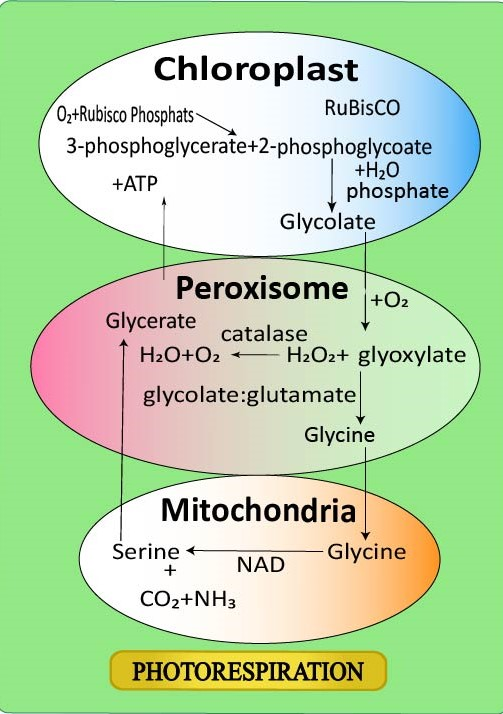Answer
425.1k+ views
Hint: In this process oxidation of RuBisCo enzyme takes place and oxygenates into RuBP, here some of the energy is wasted which was produced during photosynthesis. That is why it is also known as a wasteful pathway. It increases with the increase in temperature and ${ C }_{ O }_{ 2 }$ concentration.
Complete answer:
Photorespiration is favored by high ${ O }_{ 2 }$ and low ${ C }_{ O }_{ 2 }$ conditions.
During the Calvin cycle, the enzyme RuBisCo attaches to carbon dioxide and starts producing sugar through different stages of the Calvin cycle. But sometimes when the concentration of oxygen is higher than carbon dioxide, then the RuBisCo gets attached to ${ O }_{ 2 }$ instead of ${ C }_{ O }_{ 2 }$. Thus causes the beginning of the photorespiration process. During photorespiration ${ C }_{ O }_{ 2 }$ is released and also energy is utilized. So, we can say that photorespiration wastes energy and decreases the synthesis of sugar, as it releases carbon dioxide utilized for the production of sugar.
It is also known as the $C_2$ cycle. It is initiated in chloroplasts, but it occurs in peroxisomes.

Rate of photorespiration increased by:
-When stomata are closed to prevent water loss, the amount of ${ O }_{ 2 }$ gas increases, and ${ C }_{ O }_{ 2 }$ gas decreases.
-An increase in temperature causes the inability to recognize ${ O }_{ 2 }$ or ${ C }_{ O }_{ 2 }$ by RuBisCo and also reduces the solubility of ${ C }_{ O }_{ 2 }$ that results in a decrease in ${ C }_{ O }_{ 2 }$ concentration.
So, the correct answer is, ‘high ${ O }_{ 2 }$ and low ${ C }_{ O }_{ 2 }$’
Note:
-Rubisco makes up ${ 30 }$%, percent, or more of the soluble protein in a typical plant leaf
ribulose-1,5-bisphosphate (RuBP).
-Photorespiration is also known as the $C_2$ cycle. It begins in chloroplast but occurs in peroxisomes.
-Photorespiration increases with an increase in temperature. Photorespiration does not produce any ATP and leads to a net loss of carbon and nitrogen (as ammonia), as a result, it slowdowns the process of plant growth.
Complete answer:
Photorespiration is favored by high ${ O }_{ 2 }$ and low ${ C }_{ O }_{ 2 }$ conditions.
During the Calvin cycle, the enzyme RuBisCo attaches to carbon dioxide and starts producing sugar through different stages of the Calvin cycle. But sometimes when the concentration of oxygen is higher than carbon dioxide, then the RuBisCo gets attached to ${ O }_{ 2 }$ instead of ${ C }_{ O }_{ 2 }$. Thus causes the beginning of the photorespiration process. During photorespiration ${ C }_{ O }_{ 2 }$ is released and also energy is utilized. So, we can say that photorespiration wastes energy and decreases the synthesis of sugar, as it releases carbon dioxide utilized for the production of sugar.
It is also known as the $C_2$ cycle. It is initiated in chloroplasts, but it occurs in peroxisomes.

Rate of photorespiration increased by:
-When stomata are closed to prevent water loss, the amount of ${ O }_{ 2 }$ gas increases, and ${ C }_{ O }_{ 2 }$ gas decreases.
-An increase in temperature causes the inability to recognize ${ O }_{ 2 }$ or ${ C }_{ O }_{ 2 }$ by RuBisCo and also reduces the solubility of ${ C }_{ O }_{ 2 }$ that results in a decrease in ${ C }_{ O }_{ 2 }$ concentration.
So, the correct answer is, ‘high ${ O }_{ 2 }$ and low ${ C }_{ O }_{ 2 }$’
Note:
-Rubisco makes up ${ 30 }$%, percent, or more of the soluble protein in a typical plant leaf
ribulose-1,5-bisphosphate (RuBP).
-Photorespiration is also known as the $C_2$ cycle. It begins in chloroplast but occurs in peroxisomes.
-Photorespiration increases with an increase in temperature. Photorespiration does not produce any ATP and leads to a net loss of carbon and nitrogen (as ammonia), as a result, it slowdowns the process of plant growth.
Recently Updated Pages
How many sigma and pi bonds are present in HCequiv class 11 chemistry CBSE

Why Are Noble Gases NonReactive class 11 chemistry CBSE

Let X and Y be the sets of all positive divisors of class 11 maths CBSE

Let x and y be 2 real numbers which satisfy the equations class 11 maths CBSE

Let x 4log 2sqrt 9k 1 + 7 and y dfrac132log 2sqrt5 class 11 maths CBSE

Let x22ax+b20 and x22bx+a20 be two equations Then the class 11 maths CBSE

Trending doubts
Fill the blanks with the suitable prepositions 1 The class 9 english CBSE

At which age domestication of animals started A Neolithic class 11 social science CBSE

Which are the Top 10 Largest Countries of the World?

Give 10 examples for herbs , shrubs , climbers , creepers

Difference between Prokaryotic cell and Eukaryotic class 11 biology CBSE

Difference Between Plant Cell and Animal Cell

Write a letter to the principal requesting him to grant class 10 english CBSE

Change the following sentences into negative and interrogative class 10 english CBSE

Fill in the blanks A 1 lakh ten thousand B 1 million class 9 maths CBSE



